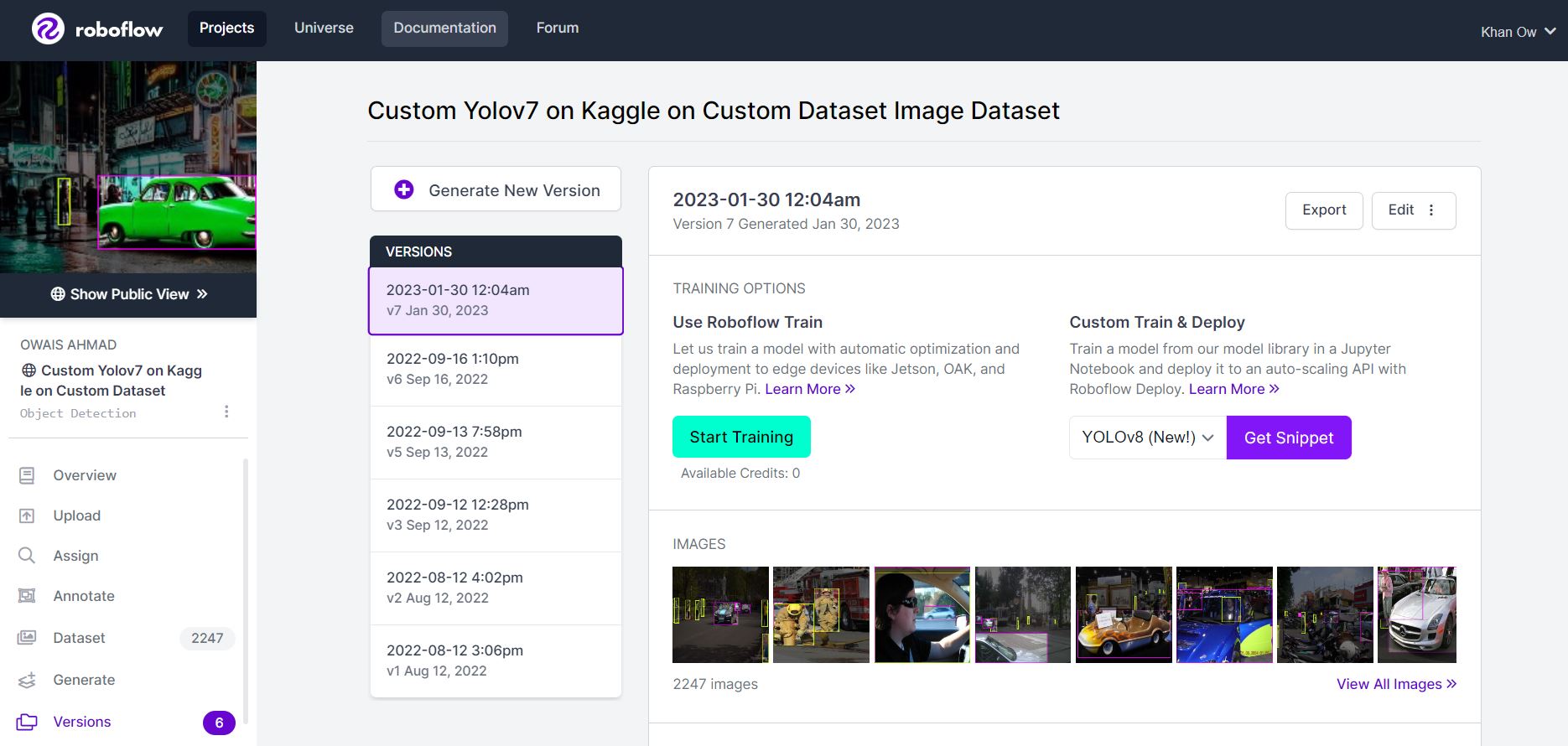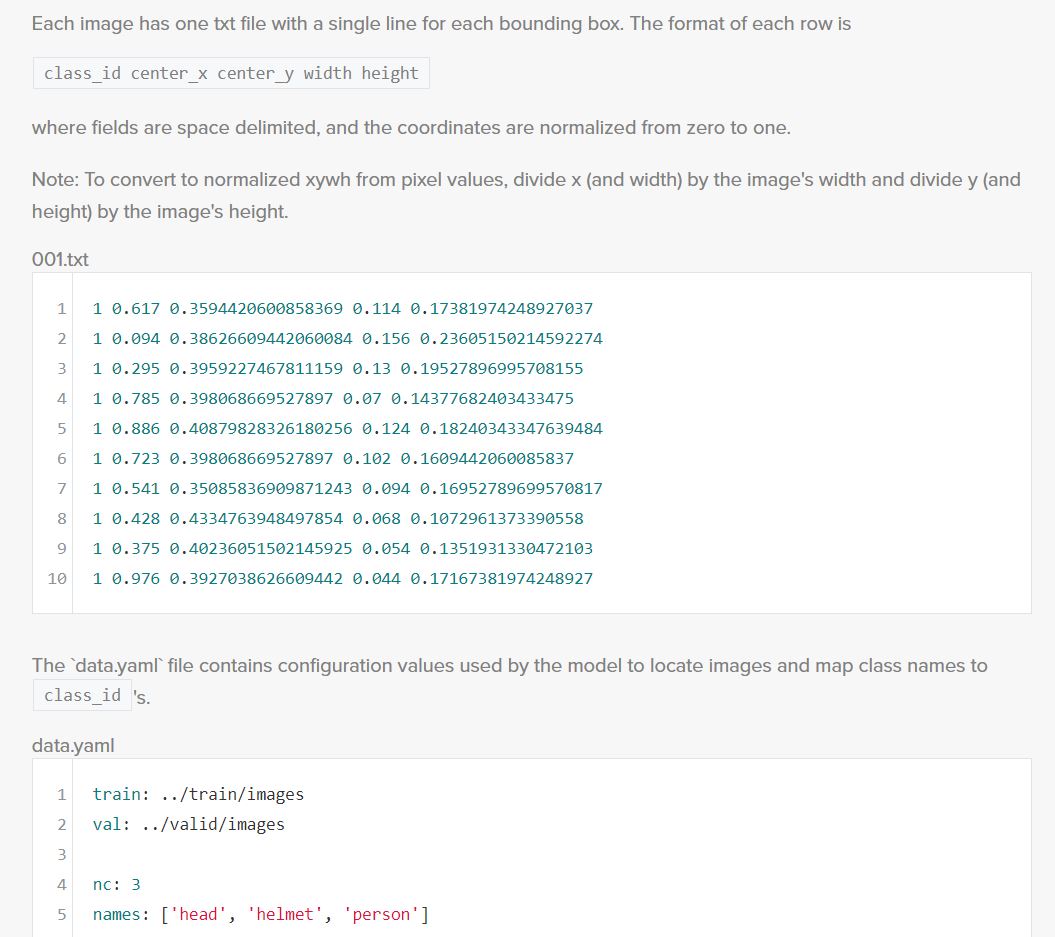|
--- |
|
tags: |
|
- V20 |
|
metrics: |
|
- mAP_0.5:0.95 |
|
- mAP_0.5 |
|
--- |
|
|
|
# Custom Training with YOLOv7 🔥 |
|
|
|
## Some Important links |
|
- [Model Inference🤖](https://huggingface.co/spaces/owaiskha9654/Custom_Yolov7) |
|
- [**🚀Training Yolov7 on Kaggle**](https://www.kaggle.com/code/owaiskhan9654/training-yolov7-on-kaggle-on-custom-dataset) |
|
- [Weight and Biases 🐝](https://wandb.ai/owaiskhan9515/YOLOR) |
|
- [HuggingFace 🤗 Model Repo](https://huggingface.co/owaiskha9654/Yolov7_Custom_Object_Detection) |
|
|
|
## Contact Information |
|
|
|
|
|
- **Name** - Owais Ahmad |
|
- **Phone** - +91-9515884381 |
|
- **Email** - owaiskhan9654@gmail.com |
|
- **Portfolio** - https://owaiskhan9654.github.io/ |
|
|
|
# Objective |
|
|
|
## To Showcase custom Object Detection on the Given Dataset to train and Infer the Model using newly launched YoloV7. |
|
|
|
# Data Acquisition |
|
|
|
The goal of this task is to train a model that |
|
can localize and classify each instance of **Person** and **Car** as accurately as possible. |
|
|
|
- [Link to the Downloadable Dataset](https://www.kaggle.com/datasets/owaiskhan9654/car-person-v2-roboflow) |
|
|
|
|
|
```python |
|
from IPython.display import Markdown, display |
|
|
|
display(Markdown("../input/Car-Person-v2-Roboflow/README.roboflow.txt")) |
|
``` |
|
|
|
# Custom Training with YOLOv7 🔥 |
|
|
|
In this Notebook, I have processed the images with RoboFlow because in COCO formatted dataset was having different dimensions of image and Also data set was not splitted into different Format. |
|
To train a custom YOLOv7 model we need to recognize the objects in the dataset. To do so I have taken the following steps: |
|
|
|
* Export the dataset to YOLOv7 |
|
* Train YOLOv7 to recognize the objects in our dataset |
|
* Evaluate our YOLOv7 model's performance |
|
* Run test inference to view performance of YOLOv7 model at work |
|
|
|
|
|
# 📦 [YOLOv7](https://github.com/WongKinYiu/yolov7) |
|
<div align=left><img src="https://raw.githubusercontent.com/WongKinYiu/yolov7/main/figure/performance.png" width=800> |
|
|
|
|
|
**Image Credit** - [WongKinYiu](https://github.com/WongKinYiu/yolov7) |
|
</div> |
|
# Step 1: Install Requirements |
|
|
|
|
|
```python |
|
!git clone https://github.com/WongKinYiu/yolov7 # Downloading YOLOv7 repository and installing requirements |
|
%cd yolov7 |
|
!pip install -qr requirements.txt |
|
!pip install -q roboflow |
|
|
|
``` |
|
|
|
# **Downloading YOLOV7 starting checkpoint** |
|
|
|
|
|
```python |
|
!wget "https://github.com/WongKinYiu/yolov7/releases/download/v0.1/yolov7.pt" |
|
``` |
|
|
|
|
|
```python |
|
import os |
|
import glob |
|
import wandb |
|
import torch |
|
from roboflow import Roboflow |
|
from kaggle_secrets import UserSecretsClient |
|
from IPython.display import Image, clear_output, display # to display images |
|
|
|
|
|
|
|
print(f"Setup complete. Using torch {torch.__version__} ({torch.cuda.get_device_properties(0).name if torch.cuda.is_available() else 'CPU'})") |
|
``` |
|
|
|
<img src="https://camo.githubusercontent.com/dd842f7b0be57140e68b2ab9cb007992acd131c48284eaf6b1aca758bfea358b/68747470733a2f2f692e696d6775722e636f6d2f52557469567a482e706e67"> |
|
|
|
> I will be integrating W&B for visualizations and logging artifacts and comparisons of different models! |
|
> |
|
> [YOLOv7-Car-Person-Custom](https://wandb.ai/owaiskhan9515/YOLOR) |
|
|
|
|
|
|
|
```python |
|
try: |
|
user_secrets = UserSecretsClient() |
|
wandb_api_key = user_secrets.get_secret("wandb_api") |
|
wandb.login(key=wandb_api_key) |
|
anonymous = None |
|
except: |
|
wandb.login(anonymous='must') |
|
print('To use your W&B account,\nGo to Add-ons -> Secrets and provide your W&B access token. Use the Label name as WANDB. \nGet your W&B access token from here: https://wandb.ai/authorize') |
|
|
|
|
|
|
|
wandb.init(project="YOLOv7",name=f"7. YOLOv7-Car-Person-Custom-Run-7") |
|
``` |
|
|
|
# Step 2: Assemble Our Dataset |
|
|
|
|
|
 |
|
|
|
In order to train our custom model, we need to assemble a dataset of representative images with bounding box annotations around the objects that we want to detect. And we need our dataset to be in YOLOv7 format. |
|
|
|
In Roboflow, We can choose between two paths: |
|
|
|
* Convert an existing Coco dataset to YOLOv7 format. In Roboflow it supports over [30 formats object detection formats](https://roboflow.com/formats) for conversion. |
|
* Uploading only these raw images and annotate them in Roboflow with [Roboflow Annotate](https://docs.roboflow.com/annotate). |
|
|
|
|
|
|
|
# Version v7 Jan 30, 2023 Looks like this. |
|
|
|
 |
|
|
|
|
|
### Since paid credits are required to train the model on RoboFlow I have used Kaggle Free resources to train it here |
|
|
|
|
|
|
|
### Note you can import any other data from other sources. Just remember to keep in the Yolov7 Pytorch form accept |
|
|
|
 |
|
|
|
```python |
|
user_secrets = UserSecretsClient() |
|
roboflow_api_key = user_secrets.get_secret("roboflow_api") |
|
``` |
|
|
|
|
|
```python |
|
rf = Roboflow(api_key=roboflow_api_key) |
|
project = rf.workspace("owais-ahmad").project("custom-yolov7-on-kaggle-on-custom-dataset-rakiq") |
|
dataset = project.version(2).download("yolov7") |
|
``` |
|
|
|
# Step 3: Training Custom pretrained YOLOv7 model |
|
|
|
Here, I am able to pass a number of arguments: |
|
- **img:** define input image size |
|
- **batch:** determine batch size |
|
- **epochs:** define the number of training epochs. (Note: often, 3000+ are common here nut since I am using free version of colab I will be only defining it to 20!) |
|
- **data:** Our dataset locaiton is saved in the `./yolov7/Custom-Yolov7-on-Kaggle-on-Custom-Dataset-2` folder. |
|
- **weights:** specifying a path to weights to start transfer learning from. Here I have choosen a generic COCO pretrained checkpoint. |
|
- **cache:** caching images for faster training |
|
|
|
|
|
```python |
|
!python train.py --batch 16 --cfg cfg/training/yolov7.yaml --epochs 30 --data {dataset.location}/data.yaml --weights 'yolov7.pt' --device 0 |
|
|
|
``` |
|
|
|
# Run Inference With Trained Weights |
|
Testing inference with a pretrained checkpoint on contents of `./Custom-Yolov7-on-Kaggle-on-Custom-Dataset-2/test/images` folder downloaded from Roboflow. |
|
|
|
|
|
```python |
|
!python detect.py --weights runs/train/exp/weights/best.pt --img 416 --conf 0.75 --source ./Custom-Yolov7-on-Kaggle-on-Custom-Dataset-2/test/images |
|
``` |
|
|
|
# Display inference on ALL test images |
|
|
|
|
|
```python |
|
for images in glob.glob('runs/detect/exp/*.jpg')[0:10]: |
|
display(Image(filename=images)) |
|
``` |
|
|
|
|
|
```python |
|
model = torch.load('runs/train/exp/weights/best.pt') |
|
``` |
|
|
|
# Conclusion and Next Steps |
|
|
|
Now this trained custom YOLOv7 model can be used to recognize **Person** and **Cars** form any given Images. |
|
|
|
To improve the model's performance, I might perform more interating on the datasets coverage,propper annotations and and Image quality. From orignal authors of **Yolov7** this guide has been given for [model performance improvement](https://github.com/WongKinYiu/yolov7). |
|
|
|
To deploy our model to an application by [exporting your model to deployment destinations](https://github.com/WongKinYiu/yolov7/issues). |
|
|
|
Once our model is in production, I will be willing to continually iterate and improve on your dataset and model via [active learning](https://blog.roboflow.com/what-is-active-learning/). |
|
|